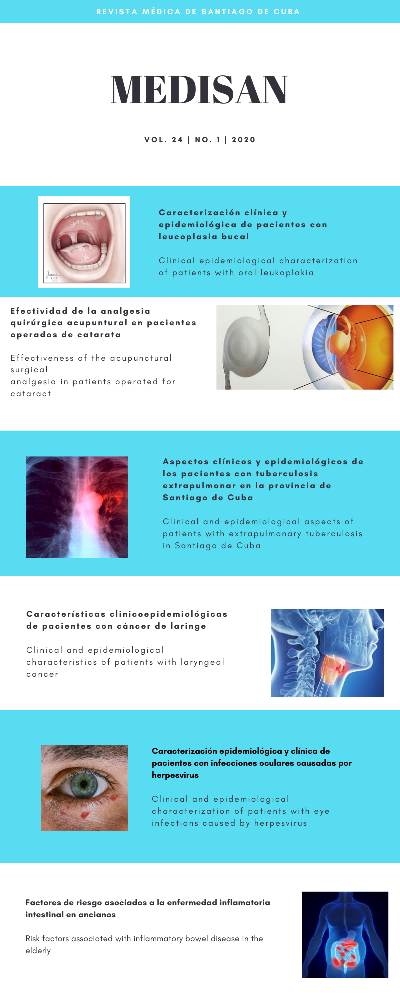Some considerations on the trochleoplasty of distal femur
Keywords:
poor patellofemoral alignment, distal femur dysplasia, trochlear dysplasia, computerized axial tomographyAbstract
The poor patellofemoral alignment has multiple anatomical causes and one of them is the dysplasia of the distal femur trochlea, reason why its treatment depends on several factors. To deepen in the essential elements of the trochleoplasty technique, an exhaustive literature review was carried out where some aspects of interest were analyzed, that is: most used classification for the trochlear dysplasias, most important imagenologic elements, indications of the surgical technique, contraindications, main modalities of trochleoplasty and surgical approaches. It was concluded that this is a procedure with very specific indications and can be carried out by means of open surgery or arthroscopic way.
Downloads
References
2. Dejour D, Renato P, Saggin R. Sulcus deepening trochleoplasty. En: Sanchis Alfonso V. Atlas of Patellofemoral Joint. London: Springer Verlag; 2013.p.211-5.
3. Carstensen SE, Menzer HM, Diduch DR. Patellar Instability: When is Trochleoplasty Necessary? Sports Med Arthrosc Rev. 2017 [citado 15/08/2018]; 25(2). Disponible en: https://www.ncbi.nlm.nih.gov/pubmed/28459752
4. Tigchelaar S, van Sambeeck J, Koeter S, van Kampen A. A stand-alone lateral condyle-elevating trochlear osteotomy leads to high residual instability but no excessive increase in patellofemoral osteoarthritis at 12-year follow-up. Knee Surg Sports Traumatol Arthrosc. 2018 [citado 15/08/ 2018]; 26(4). Disponible en: https://www.ncbi.nlm.nih.gov/pmc/articles/PMC5876279/pdf/167_2017_Article_4602.pdf
5. Dietrich TJ, Fucentese SF, Pfirrmann CW. Imaging of individual anatomical risk factors for patellar instability. Semin Musculoskelet Radiol. 2016 [citado 09/08/2018]; 20(1). Disponible en: https://www.thieme-connect.com/products/ejournals/pdf/10.1055/s-0036-1579675.pdf
6. Nolan JE 3 rd, Schottel PC, Endres NK. Trocheleoplasty: indications and technique. Curr Rev Musculoskelet Med. 2018 [citado 10/08/2018]; 11. Disponible en: https://www.ncbi.nlm.nih.gov/pmc/articles/PMC5970113/pdf/12178_2018_Article_9478.pdf
7. Zaffagnini S, Grassi A, Zoccvo G, Rosa MA, Signorelli C, Muccioli GMM. The patellofemoral joint: dysplasia to dislocation. EFORT Open Rev. 2017 [Citado 10/08/2018]; 2(5). Disponible en: https://www.ncbi.nlm.nih.gov/pmc/articles/PMC5467684/pdf/eor-2-204.pdf
8. Dejour D, Renato P, Saggin R. Sulcus deepening trochleoplasty. En: Sanchis Alfonso V. Anterior Knee Pain and Patellar Instability. London: Springer Verlag; 2011.p.423-32.
9. Hiemstra LA, Peterson D, Youssef M, Soliman J, Banfield L, Ayeni OR. Trochleoplasty provides good clinical outcomes and an acceptable complication profile in both short and long-term follow-up. Knee Surg Sports Traumatol Arthrosc. 2019 [citado 09/12/ 2019];27(9). Disponible en: https://link.springer.com/article/10.1007%2Fs00167-018-5311
10. Balcarek P, Zimmermann F. Deepening trochleoplasty and medial patellofemoral ligament reconstruction normalize patellotrochlear congruence in severe trochlear dysplasia. Bone Joint J. 2019 [citado 08/12/2019];101(3). Disponible en: https://online.boneandjoint.org.uk/doi/abs/10.1302/0301-620X.101B3.BJJ-2018-0795.R2
11. Bauduin E, Putman S, Migaud H, Remy F, Debuyzer E, Pasquier G. Compared outcomes 16 and 25 years after lateral wedge augmentation trochleoplasty: rate of recurrent dislocation and progression to osteoarthritis. Orthop Traumatol Surg Res. 2019 [citado 10/12/2019];105(7). Disponible en: https://www.sciencedirect.com/science/article/abs/pii/S1877056819302798?via%3Dihub
12. Petri M, Ettinger M, Stuebig T, Brand S, Krettek C, Jagodzinski M, et al. Current concepts for patellar dislocation. Arch Trauma Res. 2015 [citado 10/12/2019];4(3): Disponible en: https://www.ncbi.nlm.nih.gov/pmc/articles/PMC4636822/pdf/atr-04-03-29301.pdf
13. Berruto M, Uboldi FM, Ferrua P, Vergottini G, Manunta A. Surgical treatment of objective patellar instability: long-term results. Joints. 2018 [citado 15/08/2018]; 6(1). Disponible en: https://www.ncbi.nlm.nih.gov/pmc/articles/PMC5906118/pdf/10-1055-s-0038-1636949.pdf
14. Longo UG, Vincenzo C, Mannering N, Ciuffreda M, Salvatore G, Berton A, et al. Trochleoplasty techniques provide good clinical results in patients with trochlear dysplasia. Knee Surg Sports Traumatol Arthrosc. 2018 [citado 11/12/2019]; 26(9. Disponible en: https://www.ncbi.nlm.nih.gov/pubmed/28567511
15. Dejour D, Byn P, Saggin R. Deepening Trochleoplasty for Patellar Instability. En: Zaffagnini S. Patellofemoral, Pain, Instability, and Arthritis. Berlin: Springer Verlag; 2010.p.225-32.
16. Ren B, Zhang X, Zhang L, Zhang M, Liu Y, Tian B, et a. Isolated trochleoplasty for recurrent patellar dislocation has lower outcome and higher residual instability compared with combined MPFL and trochleoplasty: a systematic review. Arch Orthop Traumatol Surg. 2019 [citado 14/12/ 2019]; 139(11). Disponible en: https://link.springer.com/article/10.1007%2Fs00402-019-03244-1
17. Dejour D, Byn P, Ntagiopoulos PG. The Lyon's sulcus-deepening trochleoplasty in previous unsuccessful patellofemoral surgery. Int Orthop. 2013 [citado 15/08/2018]; 37(3). Disponible en: https://www.ncbi.nlm.nih.gov/pmc/articles/PMC3580087/pdf/264_2012_Article_1746.pdf
18. Zaffagnini S, Previtali D, Tamborini S, Pagliazzi G, Filardo G, Candrian C. Recurrent patellar dislocations: trochleoplasty improves the results of medial patellofemoral ligament surgery only in severe trochlear dysplasia. Knee Surg Sports Traumatol Arthrosc. 2019 [citado 11/12/2019]; 27(11). Disponible en: https://link.springer.com/article/10.1007%2Fs00167-019-05469-4
19. Koh JL, Stewart C. Patellar instability. Orthop Clin North Am. 2015 [citado 10/12/2019];46(1). Disponible en: https://www.sciencedirect.com/science/article/abs/pii/S0030589814001448?via%3Dihub
20. Dejour D, Paulo R, Saggin RF, Kuhn VC. Sulcus Deepening Trochleoplasty. En: Scott WN. Insall & Scott Surgery of the Knee. 6 ed. Philadelphia: Elsevier; 2018.p.954-66.
Published
How to Cite
Issue
Section
License
All the articles can be downloaded or read for free. The journal does not charge any amount of money to the authors for the reception, edition or the publication of the articles, making the whole process completely free. Medisan has no embargo period and it is published under the license of Creative Commons, International Non Commercial Recognition 4.0, which authorizes the copy, reproduction and the total or partial distribution of the articles in any format or platform, with the conditions of citing the source of information and not to be used for profitable purposes.





